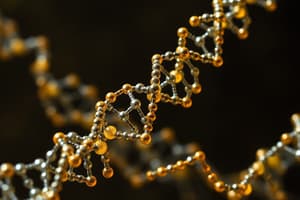Podcast
Questions and Answers
Which type of DNA is characterized by a wider right-handed spiral and is often found in dehydrated samples?
Which type of DNA is characterized by a wider right-handed spiral and is often found in dehydrated samples?
- A-DNA (correct)
- C-DNA
- B-DNA
- Z-DNA
What does the term 'nanoscale' refer to?
What does the term 'nanoscale' refer to?
- Measurements in kilometers
- Measurements in nanometres (correct)
- Measurements in millimetres
- Measurements in micrometres
Nanotechnology only involves the study of physical properties.
Nanotechnology only involves the study of physical properties.
False (B)
Z-DNA is characterized by a right-handed spiral.
Z-DNA is characterized by a right-handed spiral.
Which of the following provides an indication of the melting temperature (Tm)?
Which of the following provides an indication of the melting temperature (Tm)?
What are the four nucleotides found in Deoxyribonucleic acid (DNA)?
What are the four nucleotides found in Deoxyribonucleic acid (DNA)?
In DNA, three hydrogen bonds form between cytosine and ______.
In DNA, three hydrogen bonds form between cytosine and ______.
The diameter of a DNA double helix is approximately _____ nm.
The diameter of a DNA double helix is approximately _____ nm.
What is the melting temperature (Tm) of DNA?
What is the melting temperature (Tm) of DNA?
Match the following branches of nanotechnology with their focus areas:
Match the following branches of nanotechnology with their focus areas:
Match the DNA types with their characteristics:
Match the DNA types with their characteristics:
Hybridization refers to the process of single DNA strands forming a double helix.
Hybridization refers to the process of single DNA strands forming a double helix.
Which of the following is NOT a major property of DNA for the self-assembly of functional nanostructures?
Which of the following is NOT a major property of DNA for the self-assembly of functional nanostructures?
The double helix structure of DNA is formed by two parallel strands.
The double helix structure of DNA is formed by two parallel strands.
The formula for calculating Tm is Tm = [4(G + C) + 2(A + T)] ______
The formula for calculating Tm is Tm = [4(G + C) + 2(A + T)] ______
What is the primary aim of DNA nanotechnology?
What is the primary aim of DNA nanotechnology?
Study Notes
Nanotechnology
- Manipulation and manufacture of materials and devices at the atomic or small group of atoms scale.
- Measured in nanometres (nm), or billionths of a metre (10-9 meter).
- Materials at this scale often demonstrate unique physical and chemical properties.
Nanotechnology Fields
- Emerged as a new field over the past three decades.
- Highly diversified, encompassing various disciplines:
- Physics (surface science and semiconductor manufacturing).
- Chemistry (organic, biochemistry, analytical chemistry).
- Molecular biology.
- DNA Nanotechnology.
DNA Nanotechnology
- Aims to construct novel, controllable nanostructures using DNA's unique molecular recognition properties.
- Achieves molecular self-assembly through DNA manipulation.
- Components spontaneously organize into stable structures due to their physical and chemical properties.
- In this field, nucleic acids act as engineered building blocks rather than genetic information carriers.
DNA Properties for Self-Assembly
- Base-pairing rules of nucleotides: Adenine pairs with Thymine (A-T), Guanine pairs with Cytosine (G-C).
- Complementary strand binding: A single strand of DNA can bind to a complementary sequence with high affinity.
- Stability: DNA is stable across a wide range of environmental conditions.
- Reversible hybridization: DNA hybridization can be controlled by temperature.
DNA Fundamentals
- Deoxyribonucleic acid (DNA) contains four nucleotides, each consisting of a five-carbon sugar (deoxyribose), a heterocyclic base, and a phosphate group.
- Nucleotides include two purine molecules (Adenine and Guanine) and two pyrimidine molecules (Cytosine and Thymine).
- Two antiparallel polynucleotide strands form a double helix held together by hydrogen bonds.
- Double helix dimensions: ~2 nm diameter, ~10 - 10.5 nucleotide pairs per helical repeat, ~3.4-3.6 nm pitch.
DNA Conformations
- A-DNA: Wider right-handed spiral, found in dehydrated samples.
- B-DNA: Right-handed, most common in cells, found in high hydration levels.
- Z-DNA: Left-handed, occurs with chemically modified bases.
DNA Base Pairing
- Three hydrogen bonds form between cytosine and guanine molecules.
- Two hydrogen bonds form between adenine and thymine molecules.
- These units are referred to as base pairs.
- Base pairing is fundamental for the fabrication of many DNA-based nanostructures.
Hybridization and Denaturation
- Hybridization: Hydrogen bonding between two complementary single DNA strands forming a double helix.
- Denaturation: When double-stranded DNA is heated, it separates into single strands.
- Rehybridization: When denatured DNA cools, complementary sequences rehybridize and reform a double helix.
Melting Temperature (Tm)
- Temperature at which 50% of DNA species form a stable double helix, while the other 50% are separated into single strands.
- Depends on length and nucleotide sequence composition of the DNA molecule.
- Guanine-cytosine (GC) content is a good indicator of Tm.
- Calculation: Tm = [4(G + C) + 2(A + T)] °C
Studying That Suits You
Use AI to generate personalized quizzes and flashcards to suit your learning preferences.
Related Documents
Description
Explore the fascinating world of nanotechnology, focusing on the manipulation of materials at the atomic scale and their unique properties. This quiz delves into various fields, including physics, chemistry, and molecular biology, with special attention to DNA nanotechnology and its innovative applications. Test your knowledge on how these disciplines intersect and the future potential of nanostructures.




